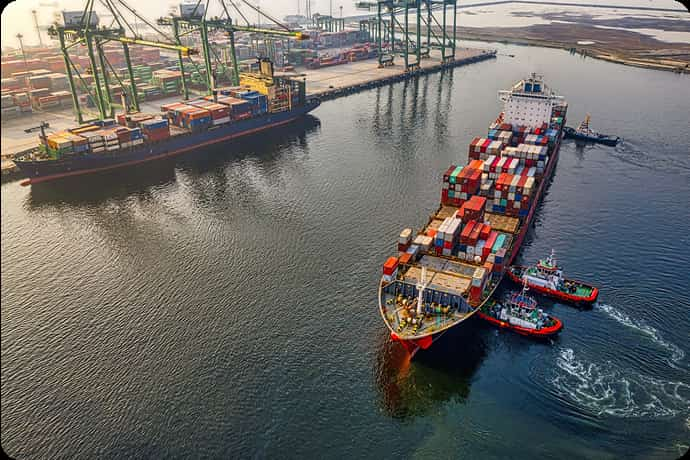The rise of Big Data in ports and terminals
Although the shipping industry is often considered traditional for its slow embrace of new technologies, many ports are harnessing the power of technological advancement.

Although the shipping industry is often considered traditional for its slow embrace of new technologies, many ports are harnessing the power of technological advancement. With the ever-increasing cargo loads and ship sizes, the pressure on ports to streamline practices is constantly on the rise.
Why Does the Maritime Industry Need Smart Solutions?
Ports are no longer just about docking ships. Stakeholders in the entire port ecosystem now work together in new, data-driven ways. When we think about the maritime industry, we often think of the port authorities, ship operators and terminal operators. As the global shipping industry has become more complex, a variety of players now exchange information in real time, including cargo and logistics companies, storage providers, rail and barge operators, trucking companies and sensor providers for pipelines, cranes, berths and roads.
As a result, these stakeholders have adopted smarter solutions to increase their productivity and be more efficient. For example, CMA CGM, operator of the third largest shipping line in the world, uses the Traxens technology to equip container ships. Smart containers now communicate information about their location via relay antennas. This technology transforms containers into smart connected objects, enabling multimodal transportation partners to prepare for the container’s arrival in port.
Same strategy for Germany’s Port of Hamburg, which recently adopted a smartPort initiative. The port extended technological assistance to other stakeholders by improving logistics, adding intelligent railway points through sensors, harnessing shore power from renewable energies and even providing an option to find free parking spaces.
Ports today must constantly improve quality, increase productivity and lower costs for shipping companies in order to compete on the international stage. Other cities like Singapore, Shanghai, Hong Kong and Taiwan have taken similar smart port initiatives, resulting in faster turnaround times for the ships and more efficient port maintenance.
The creation of intelligent solutions and smarter services has helped ports move forward. It has also helped develop collaborations and information sharing between the port authority and its partners. Copenhagen Malmö Port (CMP), a port operator connecting Denmark and Sweden invested heavily for the future and will open a new container terminal in 2021 focusing on developing new, intelligent business solutions.
Real-Time Information Helps Improve Port Efficiency
Ports across the world have been partnering with technology companies to improve port efficiency in terms of both time and money for their shipping clients. These technologies generate large amounts of data, which come in many forms and must be shared with many different port stakeholders.
Real-Time Data to Help Improve Ship Inspections.
Inspections of docked ships and port conditions often take longer than expected, and every minute spent on the dock costs shipping companies money. Aquatic Drones, a Dutch maritime technology company, has developed small, autonomous vehicles that film underwater, providing information on ship and port conditions below the water line. These drones increase inspection speed, saving time and money. Aquatic Drones is already working with the Port of Rotterdam and has just launched a test with the Port of Amsterdam.
Weather Condition Predictions to Save Money and Time
Having accurate information on weather and water levels can help shipping companies determine the best time to bring their ships into port. Bringing in the ships when the water is calm can also prove to be cost efficient as it allows for lower fuel consumption. By partnering with IBM’s The Weather Company, the Port of Rotterdam–Europe’s largest port by cargo tonnage–can access and share accurate weather data. With the help of tools like IoT sensors, augmented intelligence and smart weather data, the port provides accurate water and weather updates to allow shipping companies to predict the best conditions and time to enter the port.
Cargo Handling and Transfer
Proper information on the availability and operational efficiency of cargo handling machines like cranes and trucks is essential. Spain’s Port of Valencia has undertaken a pilot project called “black boxes,” where they installed boxes on 200 cranes straddle carriers, trucks, and forklifts in the terminal. The black boxes collect information in real time on location, status of operations, and energy consumption to avoid delays at any stage.
Data Sharing Will Help the Port Industry Capitalize on Smart Technologies to Generate New Services and Revenues
In June, the AIVP–the Worldwide Network of Port Cities–will gather in Quebec to discuss the “Next Generation” of ports. A big question going forward will not be how to capture data but rather how to manage and leverage the information ports already generate to create value.
A data sharing solution would help ports collect, combine and analyze the many sources of relevant information before cargo arrives–by land or sea. One of their big challenges is to centralize and manage all the information produced by the many maritime industry players. These initiatives will increasingly rely on data sharing platforms and API-centric solutions to link data from different sources, including shipping and logistics companies; weather, ship inspection, bridges and railway sensors; and the ports themselves. APIs will help them build applications that harness the benefits of this real-time data. However, these complex technologies do not have to be built in-house, allowing ports to specialize in what they do best. A data product solution provides the technological infrastructure to host and share different sources of data, while allowing ports to customize the data services they provide on top of that foundation.
Smart port initiatives help ports, terminals and their partners operate more efficiently and cut costs. The amount of data generated by smart sensors is a real business opportunity for companies trying to develop new data-based services and revenue streams.
Ports are now evolving as a hub not only for cargo, ships, and people, but information as well.
In collaboration with Priyanka Ketkar



